Hyundai Genesis 2016 - RHD (UK, Australia) Repair Manual
Manufacturer: HYUNDAI, Model Year: 2016, Model line: Genesis, Model: Hyundai Genesis 2016Pages: 502, PDF Size: 13.19 MB
Page 61 of 502
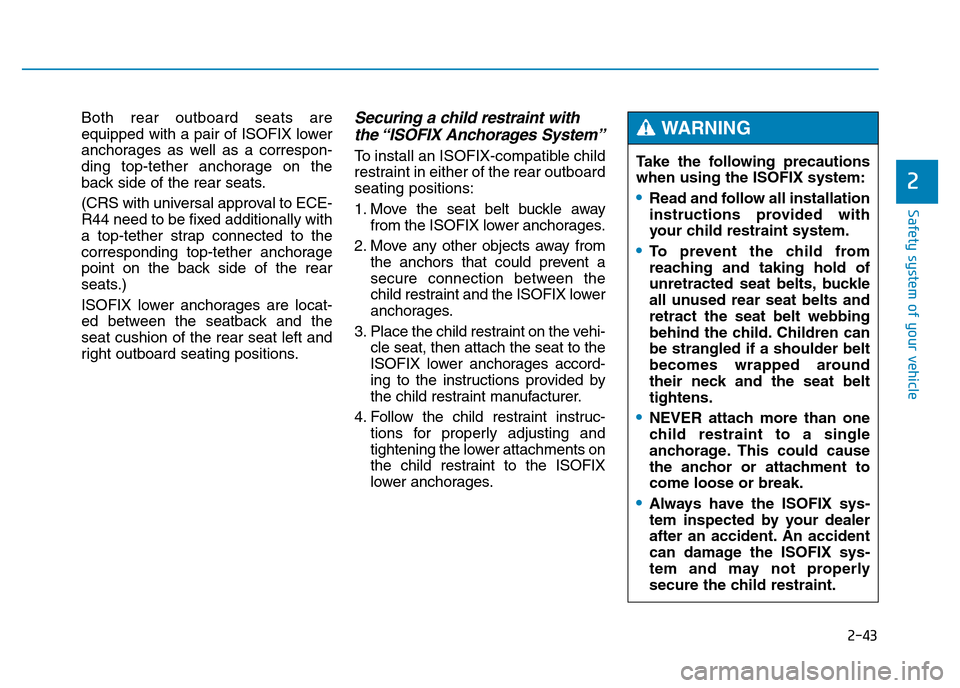
2-43
Safety system of your vehicle
2
Both rear outboard seats are
equipped with a pair of ISOFIX lower
anchorages as well as a correspon-
ding top-tether anchorage on the
back side of the rear seats.
(CRS with universal approval to ECE-
R44 need to be fixed additionally with
a top-tether strap connected to the
corresponding top-tether anchorage
point on the back side of the rear
seats.)
ISOFIX lower anchorages are locat-
ed between the seatback and the
seat cushion of the rear seat left and
right outboard seating positions.Securing a child restraint with
the “ISOFIX Anchorages System”
To install an ISOFIX-compatible child
restraint in either of the rear outboard
seating positions:
1. Move the seat belt buckle away
from the ISOFIX lower anchorages.
2. Move any other objects away from
the anchors that could prevent a
secure connection between the
child restraint and the ISOFIX lower
anchorages.
3. Place the child restraint on the vehi-
cle seat, then attach the seat to the
ISOFIX lower anchorages accord-
ing to the instructions provided by
the child restraint manufacturer.
4. Follow the child restraint instruc-
tions for properly adjusting and
tightening the lower attachments on
the child restraint to the ISOFIX
lower anchorages.Take the following precautions
when using the ISOFIX system:
•Read and follow all installation
instructions provided with
your child restraint system.
•To prevent the child from
reaching and taking hold of
unretracted seat belts, buckle
all unused rear seat belts and
retract the seat belt webbing
behind the child. Children can
be strangled if a shoulder belt
becomes wrapped around
their neck and the seat belt
tightens.
•NEVER attach more than one
child restraint to a single
anchorage. This could cause
the anchor or attachment to
come loose or break.
•Always have the ISOFIX sys-
tem inspected by your dealer
after an accident. An accident
can damage the ISOFIX sys-
tem and may not properly
secure the child restraint.
WARNING
Page 62 of 502
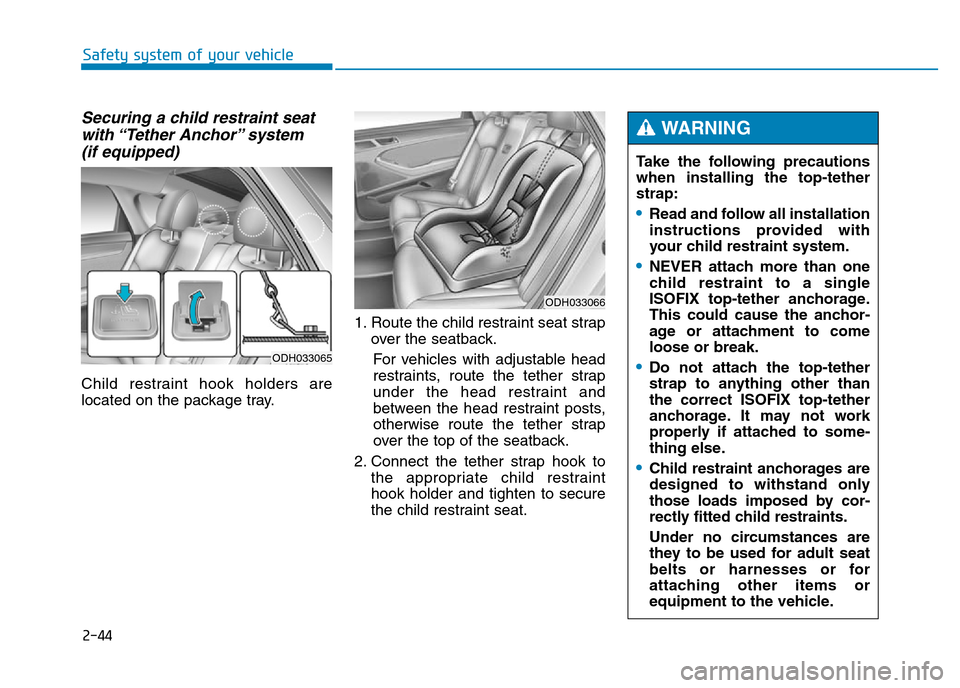
2-44
Safety system of your vehicle
Securing a child restraint seat
with “Tether Anchor” system
(if equipped)
Child restraint hook holders are
located on the package tray.1. Route the child restraint seat strap
over the seatback.
For vehicles with adjustable head
restraints, route the tether strap
under the head restraint and
between the head restraint posts,
otherwise route the tether strap
over the top of the seatback.
2. Connect the tether strap hook to
the appropriate child restraint
hook holder and tighten to secure
the child restraint seat.
ODH033065
ODH033066
Take the following precautions
when installing the top-tether
strap:
•Read and follow all installation
instructions provided with
your child restraint system.
•NEVER attach more than one
child restraint to a single
ISOFIX top-tether anchorage.
This could cause the anchor-
age or attachment to come
loose or break.
•Do not attach the top-tether
strap to anything other than
the correct ISOFIX top-tether
anchorage. It may not work
properly if attached to some-
thing else.
•Child restraint anchorages are
designed to withstand only
those loads imposed by cor-
rectly fitted child restraints.
Under no circumstances are
they to be used for adult seat
belts or harnesses or for
attaching other items or
equipment to the vehicle.
WARNING
Page 63 of 502
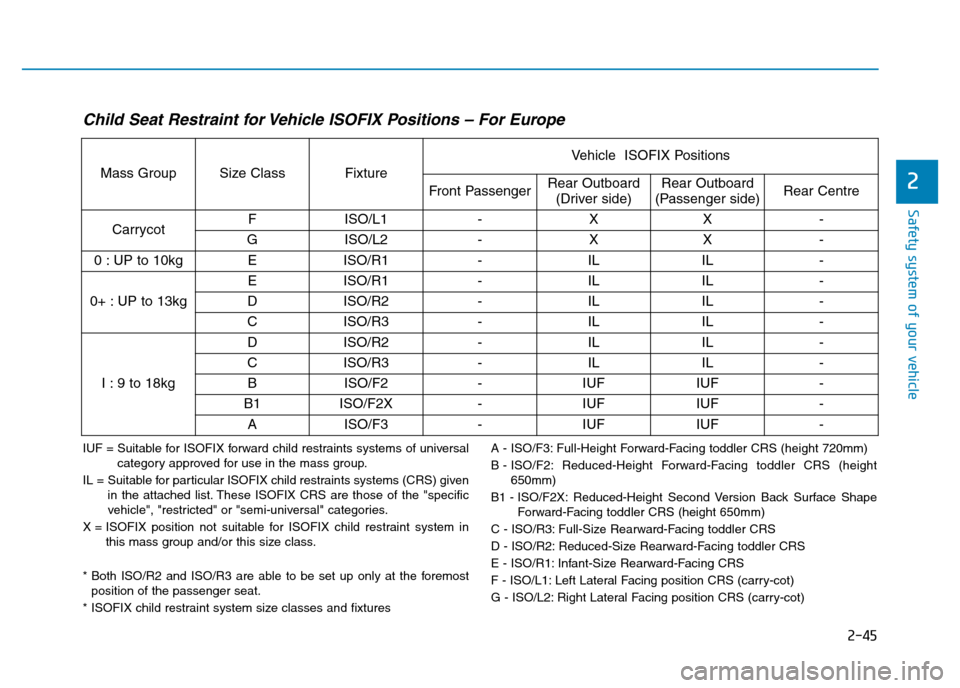
2-45
Safety system of your vehicle
2
Child Seat Restraint for Vehicle ISOFIX Positions – For Europe
IUF = Suitable for ISOFIX forward child restraints systems of universal
category approved for use in the mass group.
IL = Suitable for particular ISOFIX child restraints systems (CRS) given
in the attached list. These ISOFIX CRS are those of the "specific
vehicle", "restricted" or "semi-universal" categories.
X = ISOFIX position not suitable for ISOFIX child restraint system in
this mass group and/or this size class.
* Both ISO/R2 and ISO/R3 are able to be set up only at the foremost
position of the passenger seat.
* ISOFIX child restraint system size classes and fixturesA - ISO/F3: Full-Height Forward-Facing toddler CRS (height 720mm)
B - ISO/F2: Reduced-Height Forward-Facing toddler CRS (height
650mm)
B1 - ISO/F2X: Reduced-Height Second Version Back Surface Shape
Forward-Facing toddler CRS (height 650mm)
C - ISO/R3: Full-Size Rearward-Facing toddler CRS
D - ISO/R2: Reduced-Size Rearward-Facing toddler CRS
E - ISO/R1: Infant-Size Rearward-Facing CRS
F - ISO/L1: Left Lateral Facing position CRS (carry-cot)
G - ISO/L2: Right Lateral Facing position CRS (carry-cot)
Mass Group Size Class FixtureVehicle ISOFIX Positions
Front PassengerRear Outboard
(Driver side)Rear Outboard
(Passenger side)Rear Centre
CarrycotF ISO/L1 - X X -
G ISO/L2 - X X -
0 : UP to 10kg E ISO/R1 - IL IL -
0+ : UP to 13kgE ISO/R1 - IL IL -
D ISO/R2 - IL IL -
C ISO/R3 - IL IL -
I : 9 to 18kgD ISO/R2 - IL IL -
C ISO/R3 - IL IL -
B ISO/F2 - IUF IUF -
B1 ISO/F2X - IUF IUF -
A ISO/F3 - IUF IUF -
Page 64 of 502
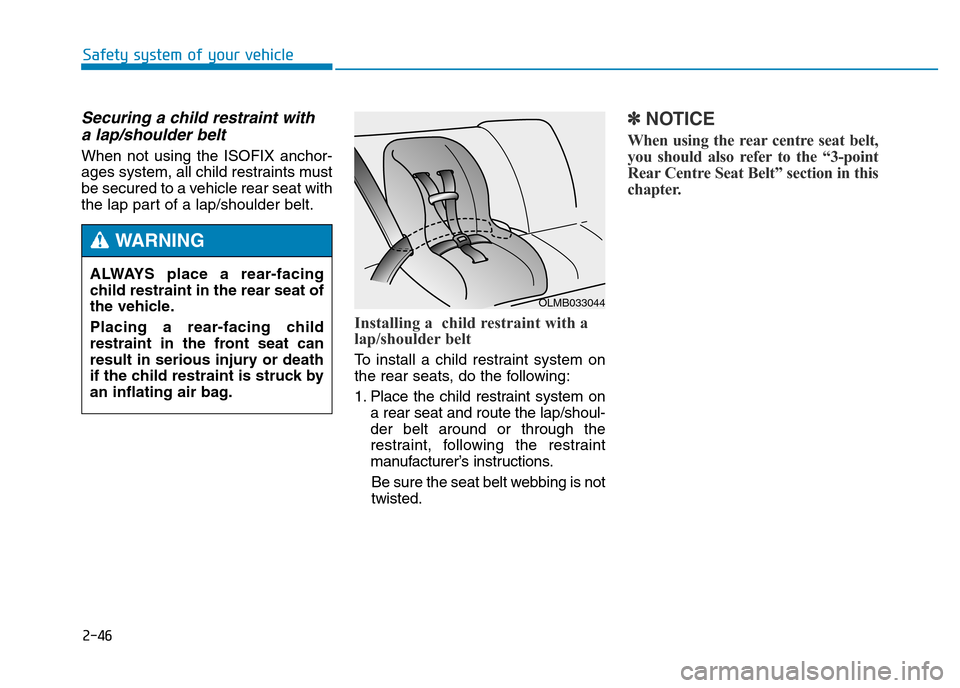
2-46
Safety system of your vehicle
Securing a child restraint with
a lap/shoulder belt
When not using the ISOFIX anchor-
ages system, all child restraints must
be secured to a vehicle rear seat with
the lap part of a lap/shoulder belt.
Installing a child restraint with a
lap/shoulder belt
To install a child restraint system on
the rear seats, do the following:
1. Place the child restraint system on
a rear seat and route the lap/shoul-
der belt around or through the
restraint, following the restraint
manufacturer’s instructions.
Be sure the seat belt webbing is not
twisted.
✽NOTICE
When using the rear centre seat belt,
you should also refer to the “3-point
Rear Centre Seat Belt” section in this
chapter.
ALWAYS place a rear-facing
child restraint in the rear seat of
the vehicle.
Placing a rear-facing child
restraint in the front seat can
result in serious injury or death
if the child restraint is struck by
an inflating air bag.
WARNING
OLMB033044
Page 65 of 502
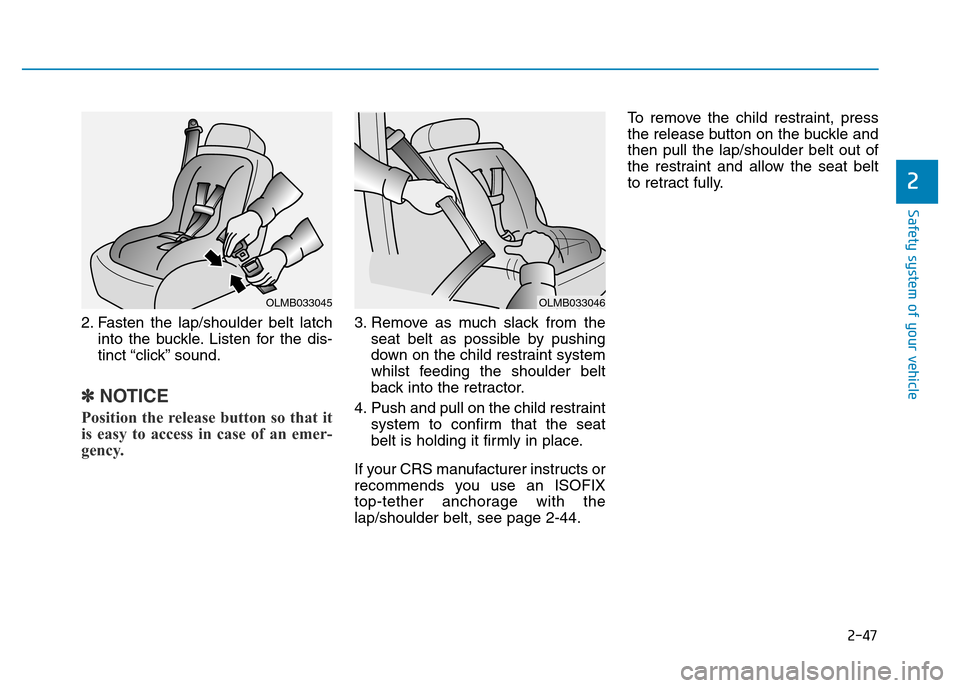
2-47
Safety system of your vehicle
2
2. Fasten the lap/shoulder belt latch
into the buckle. Listen for the dis-
tinct “click” sound.
✽NOTICE
Position the release button so that it
is easy to access in case of an emer-
gency.
3. Remove as much slack from the
seat belt as possible by pushing
down on the child restraint system
whilst feeding the shoulder belt
back into the retractor.
4. Push and pull on the child restraint
system to confirm that the seat
belt is holding it firmly in place.
If your CRS manufacturer instructs or
recommends you use an ISOFIX
top-tether anchorage with the
lap/shoulder belt, see page 2-44.To remove the child restraint, press
the release button on the buckle and
then pull the lap/shoulder belt out of
the restraint and allow the seat belt
to retract fully.
OLMB033045OLMB033046
Page 66 of 502
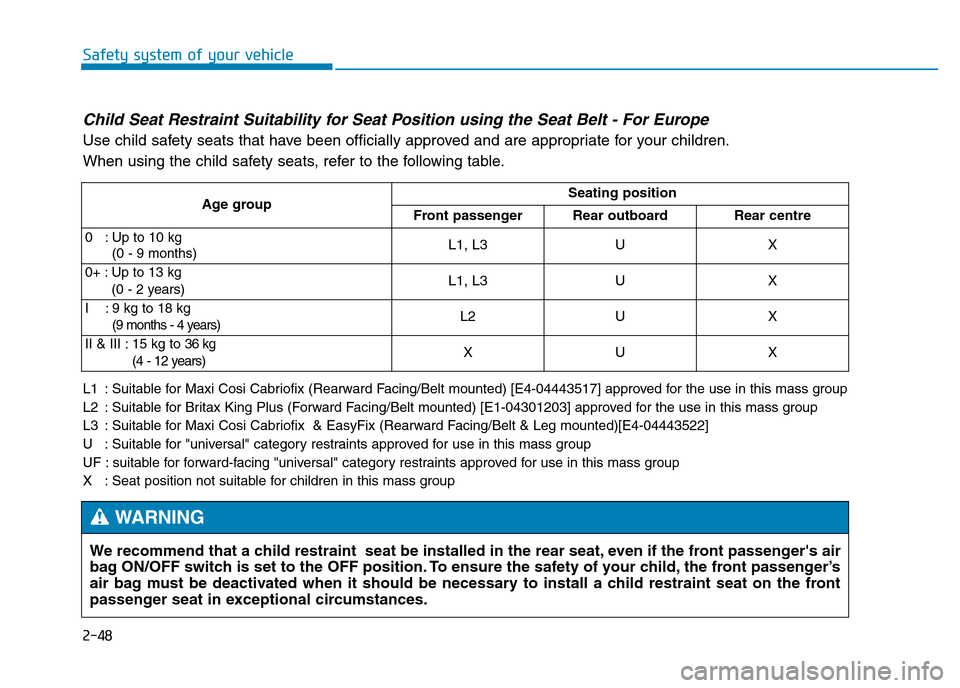
2-48
Safety system of your vehicle
Child Seat Restraint Suitability for Seat Position using the Seat Belt - For Europe
Use child safety seats that have been officially approved and are appropriate for your children.
When using the child safety seats, refer to the following table.
L1 : Suitable for Maxi Cosi Cabriofix (Rearward Facing/Belt mounted) [E4-04443517] approved for the use in this mass group
L2 : Suitable for Britax King Plus (Forward Facing/Belt mounted) [E1-04301203] approved for the use in this mass group
L3 : Suitable for Maxi Cosi Cabriofix & EasyFix (Rearward Facing/Belt & Leg mounted)[E4-04443522]
U : Suitable for "universal" category restraints approved for use in this mass group
UF : suitable for forward-facing "universal" category restraints approved for use in this mass group
X : Seat position not suitable for children in this mass group
Age groupSeating position
Front passengerRear outboardRear centre
0 : Up to 10 kg
(0 - 9 months)L1, L3UX
0+ : Up to 13 kg
(0 - 2 years)L1, L3UX
I : 9 kg to 18 kg
(9 months - 4 years)L2UX
II & III : 15 kg to 36 kg
(4 - 12 years)XUX
We recommend that a child restraint seat be installed in the rear seat, even if the front passenger's air
bag ON/OFF switch is set to the OFF position. To ensure the safety of your child, the front passenger’s
air bag must be deactivated when it should be necessary to install a child restraint seat on the front
passenger seat in exceptional circumstances.
WARNING
Page 67 of 502
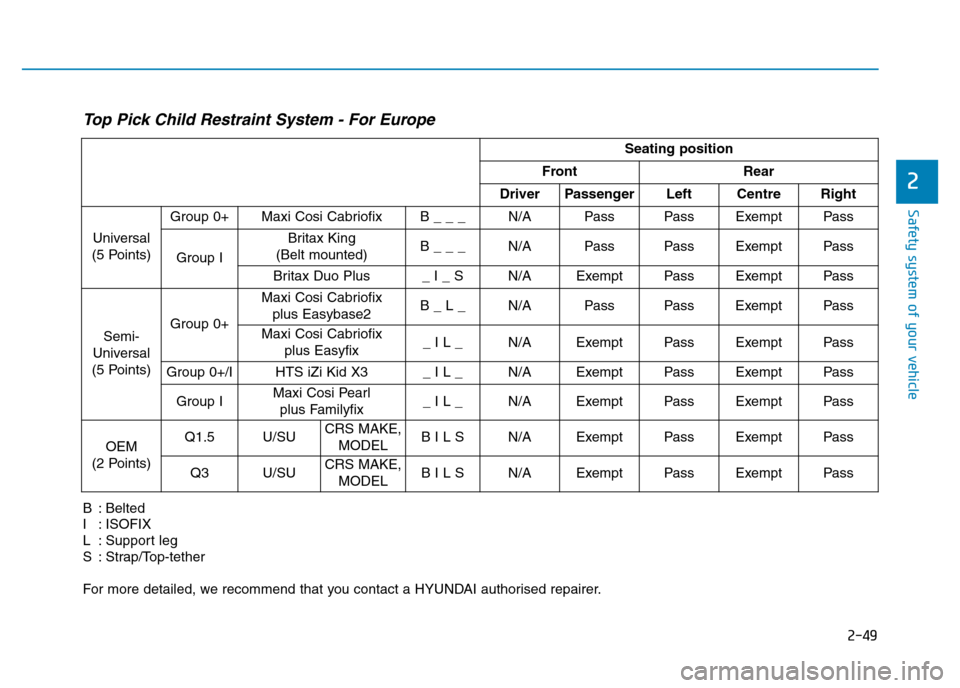
2-49
Safety system of your vehicle
2
Top Pick Child Restraint System - For Europe
B : Belted
I : ISOFIX
L : Support leg
S : Strap/Top-tether
For more detailed, we recommend that you contact a HYUNDAI authorised repairer.Seating position
Front Rear
Driver Passenger Left Centre Right
Universal
(5 Points)Group 0+ Maxi Cosi Cabriofix B _ _ _ N/A Pass Pass Exempt Pass
Group IBritax King
(Belt mounted)B _ _ _ N/A Pass Pass Exempt Pass
Britax Duo Plus _ I _ S N/A Exempt Pass Exempt Pass
Semi-
Universal
(5 Points)Group 0+Maxi Cosi Cabriofix
plus Easybase2 B _ L _ N/A Pass Pass Exempt Pass
Maxi Cosi Cabriofix
plus Easyfix _ I L _ N/A Exempt Pass Exempt Pass
Group 0+/I HTS iZi Kid X3 _ I L _ N/A Exempt Pass Exempt Pass
Group IMaxi Cosi Pearl
plus Familyfix_ I L _ N/A Exempt Pass Exempt Pass
OEM
(2 Points)Q1.5 U/SUCRS MAKE,
MODELB I L S N/A Exempt Pass Exempt Pass
Q3 U/SUCRS MAKE,
MODELB I L S N/A Exempt Pass Exempt Pass
Page 68 of 502
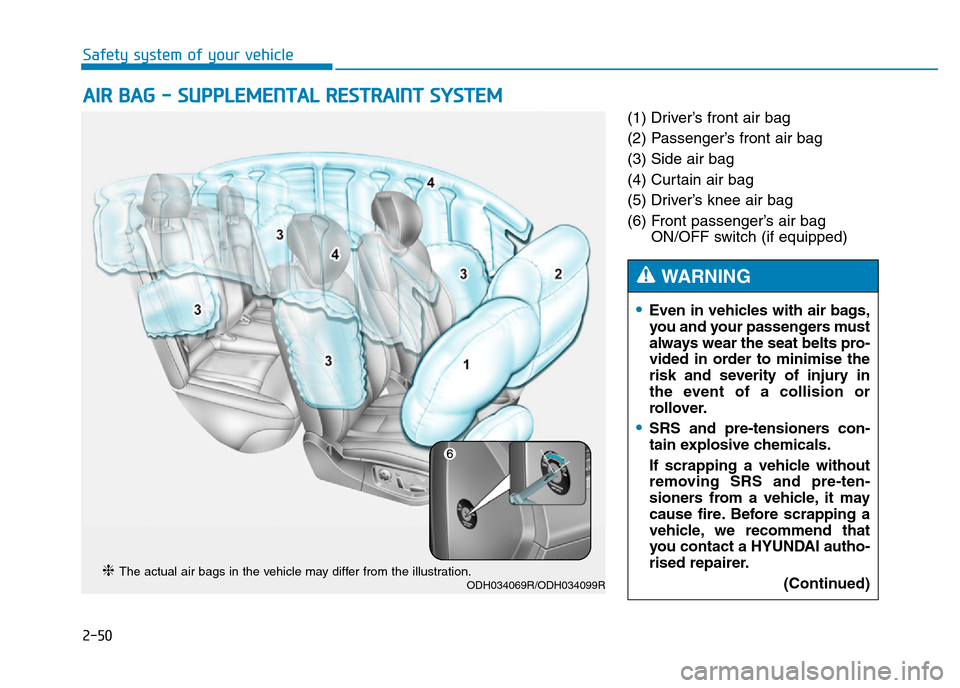
2-50
Safety system of your vehicle
(1) Driver’s front air bag
(2) Passenger’s front air bag
(3) Side air bag
(4) Curtain air bag
(5) Driver’s knee air bag
(6) Front passenger’s air bag
ON/OFF switch (if equipped)
AIR BAG - SUPPLEMENTAL RESTRAINT SYSTEM
ODH034069R/ODH034099R❈ The actual air bags in the vehicle may differ from the illustration.
•Even in vehicles with air bags,
you and your passengers must
always wear the seat belts pro-
vided in order to minimise the
risk and severity of injury in
the event of a collision or
rollover.
•SRS and pre-tensioners con-
tain explosive chemicals.
If scrapping a vehicle without
removing SRS and pre-ten-
sioners from a vehicle, it may
cause fire. Before scrapping a
vehicle, we recommend that
you contact a HYUNDAI autho-
rised repairer.
(Continued)
WARNING
Page 69 of 502
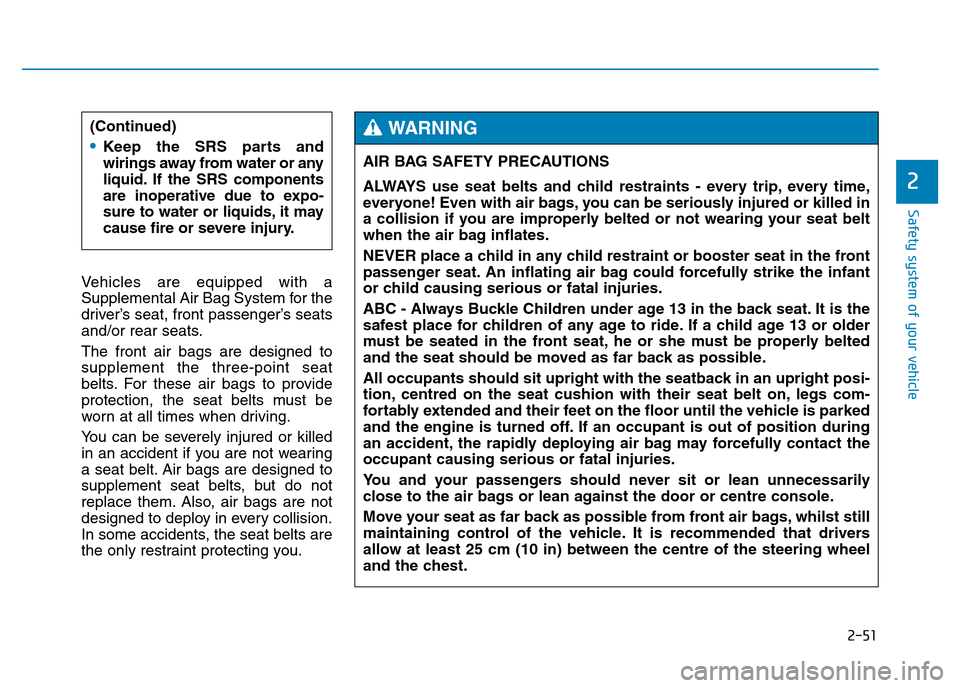
2-51
Safety system of your vehicle
2
Vehicles are equipped with a
Supplemental Air Bag System for the
driver’s seat, front passenger’s seats
and/or rear seats.
The front air bags are designed to
supplement the three-point seat
belts. For these air bags to provide
protection, the seat belts must be
worn at all times when driving.
You can be severely injured or killed
in an accident if you are not wearing
a seat belt. Air bags are designed to
supplement seat belts, but do not
replace them. Also, air bags are not
designed to deploy in every collision.
In some accidents, the seat belts are
the only restraint protecting you.AIR BAG SAFETY PRECAUTIONS
ALWAYS use seat belts and child restraints - every trip, every time,
everyone! Even with air bags, you can be seriously injured or killed in
a collision if you are improperly belted or not wearing your seat belt
when the air bag inflates.
NEVER place a child in any child restraint or booster seat in the front
passenger seat. An inflating air bag could forcefully strike the infant
or child causing serious or fatal injuries.
ABC - Always Buckle Children under age 13 in the back seat. It is the
safest place for children of any age to ride. If a child age 13 or older
must be seated in the front seat, he or she must be properly belted
and the seat should be moved as far back as possible.
All occupants should sit upright with the seatback in an upright posi-
tion, centred on the seat cushion with their seat belt on, legs com-
fortably extended and their feet on the floor until the vehicle is parked
and the engine is turned off. If an occupant is out of position during
an accident, the rapidly deploying air bag may forcefully contact the
occupant causing serious or fatal injuries.
You and your passengers should never sit or lean unnecessarily
close to the air bags or lean against the door or centre console.
Move your seat as far back as possible from front air bags, whilst still
maintaining control of the vehicle. It is recommended that drivers
allow at least 25 cm (10 in) between the centre of the steering wheel
and the chest.
WARNING (Continued)
•Keep the SRS parts and
wirings away from water or any
liquid. If the SRS components
are inoperative due to expo-
sure to water or liquids, it may
cause fire or severe injury.
Page 70 of 502
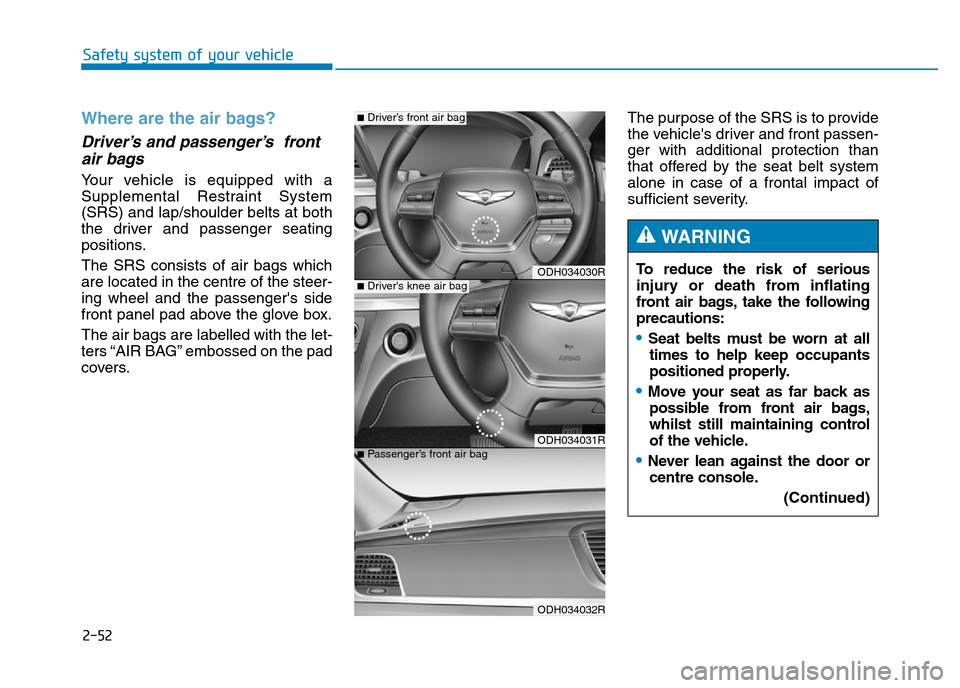
2-52
Safety system of your vehicle
Where are the air bags?
Driver’s and passenger’s front
air bags
Your vehicle is equipped with a
Supplemental Restraint System
(SRS) and lap/shoulder belts at both
the driver and passenger seating
positions.
The SRS consists of air bags which
are located in the centre of the steer-
ing wheel and the passenger's side
front panel pad above the glove box.
The air bags are labelled with the let-
ters “AIR BAG” embossed on the pad
covers.The purpose of the SRS is to provide
the vehicle's driver and front passen-
ger with additional protection than
that offered by the seat belt system
alone in case of a frontal impact of
sufficient severity.
To reduce the risk of serious
injury or death from inflating
front air bags, take the following
precautions:
•Seat belts must be worn at all
times to help keep occupants
positioned properly.
•Move your seat as far back as
possible from front air bags,
whilst still maintaining control
of the vehicle.
•Never lean against the door or
centre console.
(Continued)
WARNING
ODH034030R
ODH034031R
ODH034032R
■Driver's knee air bag
■Driver’s front air bag
■Passenger’s front air bag